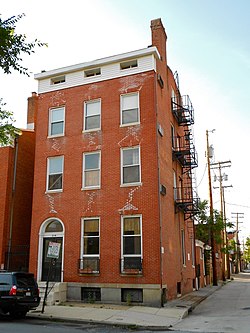Ira Remsen House
Ira Remsen House | |
 Ira Remsen House, May 2012 | |
| Location | 214 W. Monument Street, Baltimore, Maryland |
|---|---|
| Coordinates | 39°17′51″N 76°37′10″W / 39.29750°N 76.61944°W |
| Built | c. 1885 |
| NRHP reference No. | 75002102 |
| Significant dates | |
| Added to NRHP | May 15, 1975[1] |
| Designated NHL | May 15, 1975[2] |
The Ira Remsen House is a historic house at 214 West Monument Street in Baltimore, Maryland. Built in the 1880s, this nondescript row house was the home of Ira Remsen (1846-1927), a noted chemist and educator who served as president of Johns Hopkins University from 1901 to 1913, and influenced a generation of chemists and chemistry researches with his textbooks and pedagogical methods. This house was listed on the National Register of Historic Places and designated a National Historic Landmark in 1975.[1]
Description and history
[edit]The Ira Remsen House stands on the west side of Baltimore's Mount Vernon neighborhood, on the north side of West Monument Street at its junction with Tyson Street. The house is a typical row house of no particular architectural distinction. It is a three-story brick row house with a gabled roof. Its facade is three bays wide, with the main entrance in the leftmost bay, set in a rounded-arch opening. Windows are in unadorned rectangular openings with stone sills, and a wood-frame shed-roof dormer extends across the roof. The house was renovated in 1945, when the cornice was replaced, the front sandblasted, and the interior divided into three apartments.[3]
The house is notable as the residence between 1901 and 1925 of Ira Remsen. Educated in Germany as a chemist, Remsen came to Johns Hopkins University in 1876 to help build its chemistry department. His most notable research discovery was saccharine, but he was much more widely influential in his teaching methods and textbooks, which influenced a generation of students and teachers. In 1901, the year he moved into this house, he was named president of the university, succeeding Daniel Coit Gilman. He served as president until 1913, and remained active in the chemistry department until 1925. His ashes are buried on the Johns Hopkins campus, at Remsen Hall, named in his honor.[3]
See also
[edit]- List of National Historic Landmarks in Maryland
- National Register of Historic Places listings in Central Baltimore
References
[edit]- ^ a b "National Register Information System". National Register of Historic Places. National Park Service. April 15, 2008.
- ^ "Ira Remsen House". National Historic Landmark summary listing. National Park Service. Archived from the original on March 9, 2009. Retrieved June 17, 2008.
- ^ a b Sheire, James (March 1975). "National Register of Historic Places Inventory Nomination: Ira Remsen House". National Park Service. Retrieved March 25, 2009.
External links
[edit]- Ira Remsen House, Baltimore City, including photo dated 2004, at Maryland Historical Trust





